The majority of the cows from the genetic herds destined to the milk production in Cuba correspond to crossbreeding of Holstein with Cebu. Predominantly the use of the crossing 5/8 Holstein 3/8 Cebu, named Siboney de Cuba, and the 3/4 Holstein 1/4 Cebu, known as Mambí de Cuba. A low proportion represents pure Holstein.
Although at the beginning of the formation of Siboney de Cuba and Mambí de Cuba breeds, experiments to compare the performance of 5/8 Holstein 3/8 Cebu, the 3/4 Holstein 1/4 Cebu and the pure Holstein crossbreeding (Ponce de León et al. 1988) were carried out, once the breeds are conformed, there are no studies that evaluate the animals of the three breeds in production conditions to compare the advantages of using one or the other. Therefore, the objective of this study was to evaluate the genetic and environmental factors that influence on milk production, reproduction and longevity of Siboney de Cuba, Mambí de Cuba and Holstein cows.
Materials and Methods
The 1984 to 2016 records of milk production, reproduction and longevity of three genetic groups were used: Mambí de Cuba (3/4 Holstein ¼ Cebu), Siboney de Cuba (5/8 Holstein 3/8 Cebu) and Holstein, located in Centro Nacional de Control Pecuario (CENCOP). These records belong to three genetics enterprises (Empresa Pecuaria Genetica de Matanzas, Camilo Cienfuegos and Los Naranjos) from the western region of the Republic of Cuba.
The cow feeding system was based on grazing. The lactating cows intake, mainly, the Star grasses (Cynodon nlemfuensis), Pangola (Digitaria decumbens), Guinea (Megathyrsus maximus), some species of natural grass, and Cenchrus purpureus cv. Cuba CT-115. The latter as a strategic reserve for drought periods. Dried dehydrated grains with soluble (DDGS) were also supplied from 2001, at a rate of 0.46 kg/L, from the second liter produced, approximately.
During the dry season supplementation of sugarcane (Saccharum officinarum), King Grass (Cenchrus purpureus) in forage form and citrus skin was provided, according to availability. Urea and mineral salts were part of the complementary foods, as required by the diet.
The non-lactating females were in the same grazing conditions. At thirty days prepartum they received supplementation with concentrate, according to availability. They were not exceeded 2-3 kg/cow/d. During the period from 1991 to 2000, no supplement was offered to the prepartum cows. Mechanical milking was performed twice a day. The intervals between milkings were 10 and 14 h. The grazing hours in the main enterprises studied were the normal ones (morning, afternoon and evening).
Those lactations with less than 30 d of duration were eliminated. The ages at parturition, lower than 24 months and lactations higher than the tenth lactation, were grouped in the latter. The parturition time was grouped in rainy (May to October) and dry (November to April).
Different sets of data were used. The milk production data file showed a total of 131,658 lactations, from 63066 cows, with parturition years from 1987 to 2016. Of them, 50022 lactations corresponded to Mambí de Cuba (16128 cows), 51911 to Siboney de Cuba (20769 cows) and 29725 to Holstein (26169 cows). The traits of cumulative milk production up to 305 d (M305) and duration of lactation (DL) were studied. For the study of the age at first service (A first S), the information of the first lactation for 52342 cows in total was considered. Of them, 21899 were Holstein, 12637 Mambí de Cuba and 17806 Siboney de Cuba.
The data file of the reproduction showed 117 794 reproductive events, of 36331 cows, with parturition years from 1985 to 2014. Of these, 56807 events corresponded to Mambí de Cuba (16,934 cows), 48861 to Siboney de Cuba (15654 cows) and 12126 events to Holstein (3743 cows). The traits parturition-first service interval (PSI), parturition-gestation interval (PGI), and parturition interval (PI) were studied.
From the looses file of milk production, two longevity traits were calculated: the productive life (PL), such as the months of the first to the last parturition, and the number of parturition per life (PN). The file showed a total of 18741 cows, with parturition years from 1984 to 2014. Of these, 8302 cows were Mambí de Cuba, 8514 Siboney de Cuba and 1925 Holstein. The production of milk per life (MPLife) was also determined from this file. The file presented 56536 cows in total, with parturition years from 1984 to 2016. Of them, 11210 corresponded to Mambí de Cuba cows, 13863 Siboney de Cuba and 31463 Holstein cows.
A mixed linear model was applied, with the use of the SAS MIXED procedure, version 9.3 (SAS 2013) according to the type of data. The model I used for the dairy production traits (M305, DL) was:
Where:
Yijklmn |
- vector of observations of cows |
µ |
- Average mean for all observations |
Gi |
- Fixed effect of the ith genetic group of the cow (i= 1, 2,3) |
Rj |
- Fixed effect of the ith herd (j= 1, …, 474) |
NLk |
- Fixed effect of the kth lactation number (k=1,.., 10) |
APl |
- Fixed effect of the lth parturition year (l= 1987,…, 2016) |
EPm |
- Fixed effect of the m-th parturition time (m=1, 2) 1=rainy, 2=dry |
(GxNL)ik |
- Effect of the interaction of the ith genetic group of the cow with the kth lactation number (ik=1,..,30) |
(GxAP)il |
- Effect of the interaction of the ith genetic group of the cow with the lth parturition year (il=1,..,87) |
(GxEP)im |
- Effect of the interaction of the ith genetic group of the cow with the m-th parturition time(im=1,..,6) |
Vn(Rj) |
- Random effect of the nth cow (n=1, …, 63066) nested in the jth herd (j= 1, …, 474) ~ NID (0, σ2 v) |
eijklmn |
- random error associated with each observation ~ NID (0, σ2 e) The model II used for the MPLife dairy production trait was: |
Where:
Yijklmn |
- vector of cows observations |
µ |
- Average mean for all observations |
Gi |
- Fixed effect of the ith genetic group of the cow (i= 1, 2,3) |
Rj |
- Fixed effect of the jth herd (j= 1, …, 424) |
APl |
- Fixed effect of the lth parturition year (l= 1984,…, 2016) |
EPm |
- Fixed effect of the mth parturition time (m=1, 2) 1=rainy, 2=dry |
(GxAP)il |
- Effect of the interaction of the ith genetic group of the cow with the lth parturition year (il=1,..,96) |
(GxEP)im |
- Effect of the interaction of the ith genetic group of the cow with the mth parturition time (im=1,..,6) |
Vn(Rj) |
- random effect of the nth cow (n=1, …, 56536) nested in the jth herd (j= 1, …, 424) ~ NID (0, σ2 v) |
eijklmn |
- random error associated with each observation ~ NID (0, σ2 e) The model III used for the reproduction traits (PSI, PGI, PI) was: |
Where:
Yijklmn |
- vector of cows observations, |
µ |
- Average mean for all observations, |
Gi |
- Fixed effect of the ith genetic group of the cow (i= 1, 2,3) |
Rj |
- Fixed effect of the jth herd (j= 1, …, 473) |
NLk |
- Fixed effect of the kth lactation number (k=1,.., 10) |
APl |
- Fixed effect of the lth parturition year (l= 1985,…, 2014) |
EPm |
- Fixed effect of the mth parturition time (m=1, 2) 1=rainy, 2=dry, |
(GxNL)ik |
- Effect of the interaction of the ith genetic group of the cow with the kth lactation number (ik=1,..,30) |
(GxAP)il |
- Effect of the interaction of the ith genetic group of the cow with the lth parturition year (il=1,..,90) |
(GxEP)im |
- Effect of the interaction of the ith genetic group of the cow with the mth parturition time (im=1,..,6) |
Vn(Rj) |
- random effect of the nth cow (n=1, …, 36331) nested in the jth herd (j= 1, …, 473) ~ NID (0, σ2 v) |
eijklmn |
- random error associated with each observation ~ NID (0, σ2 e) The model IV used for the A first S reproduction trait was: |
Where:
Yijklmn |
- vector of cows observations |
µ |
- Average mean for all observations |
Gi |
- Fixed effect of the ih genetic group of the cow (i= 1, 2,3) |
Rj |
- Fixed effect of the jth herd (j= 1, …, 269) |
APl |
- Fixed effect of the lth year of first service (l= 1984,…, 2014) |
EPm |
- Fixed effect of the mth first service time (m=1, 2) 1=rainy, 2=dry. |
(GxAP)il |
- Effect of the interaction of the ith genetic group of the cow with the lth year of first service (il=1,..,90) |
(GxEP)im |
- Effect of the interaction of the ith genetic group of the cow with the mth first service time (im=1, 6) |
Vn(Rj) |
- random effect of the nth cow(n=1, …, 52342) nested in the jth herd (j= 1, …, 269) ~ NID (0, σ2 v) |
eijklmn |
- random error associated with each observation ~ NID (0, σ2 e) |
The model V used for (PL, PN) longetivity trait was:
Where:
Yijklmn |
- vector of the cows observations |
µ |
- Average mean for all observations |
Gi |
- Fixed effect of the ith genetic group of the cow (i= 1, 2,3) |
Rj |
- Fixed effect del jth herd (j= 1, …, 257) |
APl |
- Fixed effect of the lth year of first service (l= 1984,…, 2014) |
EPm |
- Fixed effect of the mth first service time (m=1, 2) 1=rainy, 2=dry, |
(GxAP)il |
- Effect of the interaction of the ith genetic group of the cow with the lth year of first service (il=1,..,90) |
(GxEP)im |
- Effect of the interaction of the ith genetic group of the cow with the mth first service time (im=1, 6) |
Vn(Rj) |
- random effect of the nth cow (n=1, …, 18741) nested in the jth herd(j= 1, …, 257) ~ NID (0, σ2 v) |
eijklmn |
- random error associated with each observation ~ NID (0, σ2 e) |
The Tukey-Kramer test was applied for the multiple comparison of means of least squares, according to Kramer (1956).
Results and Discussion
The variance analysis of milk production traits showed that all fixed effects studied were significant (table 1).
For the reproductive traits, the effects of parturition time and the interaction between the genetic group and parturition time did not influence on the PSI, PGI, PI and AfirstS (table 2). These effects did not influence on the PL and PN longevity traits (table 3).
Table 1 Analysis of variance of the fixed effects on milk production traits in Mambí de Cuba, Siboney de Cuba and Holstein cows

Table 2 Analysis of variance of the fixed effects on reproductive traits in Mambí de Cuba, Siboney de Cuba and Holstein cows

Table 3 Variance analysis of fixed effects on longevity and reproductive traits in Mambí de Cuba, Siboney de Cubaand Holstein cows

Regarding the studied genetic groups, it must analyze the differences between them taking into account the parturition time, the lactation number and the years of study, since the interaction genotype x parturition time, the interaction genotype x lactation number and the interaction genotype x parturition year affected the traits.
The effect of the interaction genotype x parturition time is shown in table 4. In general, the parturition time affected the traits, likewise in the cows of the three breeds, with higher averages in the dry season. When analyzing the means of the three breeds in each parturition time, there was a higher average of M 305 in Mambí de Cuba in the rainy season. However, in the dry season, the performance of Mambí did not differ with that of the Holstein. The DL was higher in Holstein in both seasons; while MPLife was higher in Mambí de Cuba in the two seasons.
Table 4 Effect of the interaction genotype x parturition time on milk production and reproduction traits in Mambí de Cuba, Siboney de Cuba and Holstein cows.

abcParameters with mismatched superscripts in the same column differ to P <0.05 (Kramer 1956).
The higher milk production in favor of the dry season was attributed, fundamentally, to the fact that at that season was a cooler environment. Temperatures were lower and favored an adequate metabolic welfare for dairy production, which infers a subsequent increase in milk production by developing lactation at the time of higher grass availability. Similar results were reported in other studies in diverse tropical conditions (García 2005 and López et al. 2009).
The effect of the interaction genotype x lactation number in milk production is shown in figure 1. In the first three lactations, the productions were higher in Mambí de Cuba, intermediate in Holstein and lower in Siboney of Cuba. From the fourth to the ninth lactation, there were no differences in milk productions of Mambí de Cuba and Holstein, which surpassed the Siboney of Cuba. In the tenth lactation, there were no differences between breeds.
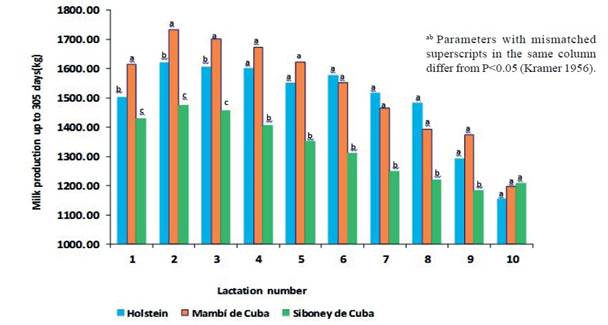
Figure 1 Effect of the interaction genotype x lactation number in milk production up to 305 days in Mambí de Cuba, Siboney de Cuba and Holstein cows
The parturitions interval (figure 2) only differed between genotypes from the fourth to the seventh parturition, with lower averages in Siboney de Cuba. In all the breeds groups there was a progressive decrease in the parturition-gestation interval and the parturition interval, with the increase in the parturition number. This performance can be attributed to the fact that cows with reproductive difficulties are usually eliminated from the herd. García et al. (2002, 2003) and López et al. (2010) also report reduction in the parturition interval, as the parturition number increased.
The highest milk production were obtained in the period from 1987 to 1990 (figure 3), with higher averages in the Holstein cows (3328.51, 3512.2, 3135.14 and 2881.15 kg, respectively) that exceeded the Mambí de Cuba (2584.24 - 2115.55 kg) and to Siboney (1917.87 - 1721.1 kg). From 1991 to 2001, the performance was unstable. In 1991, 1993 and 1999 the Holstein exceeded the Mambí de Cuba and the Siboney de Cuba. In most of the remaining years of this period, there were similar productions in Holstein and Mambí, whose averages exceeded those of Siboney de Cuba. There was a drastic reduction in production in general, which is due to the fact that this was a period of economic limitations in Cuba, in which inputs were reduced and a systematic supply of feed to lactating cows could not be maintained. Therefore, the diet was mainly based on grasses, without irrigation and fertilization.
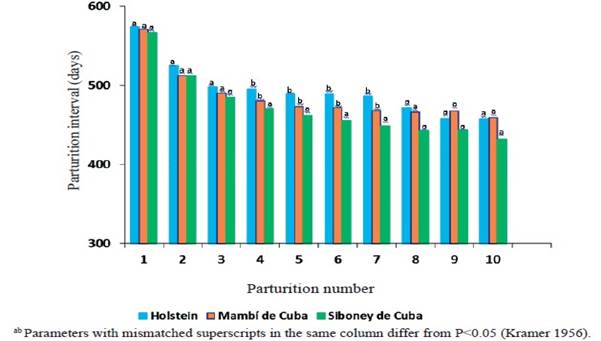
Figure 2 Effect of the interaction genotype x parturition number in the parturition interval in Mambí de Cuba, Siboney de Cuba and Holstein cows.

Figure 3 Effect of the interaction genotype x parturition year in milk production in Mambí de Cuba, Siboney de Cuba and Holstein.
From 2002 to 2007, there was a slight increase in production and differences were found between genotypes. They were higher in Mambí de Cuba, from 2002 to 2004, with averages of 1850.30 ± 44.30, 1917.56 ± 50.65 and 1761.85 ± 35.41 kg, respectively. While, from 2005 to 2007, and from 2009 to 2012, Mambí de Cuba and Siboney de Cuba showed similar productions.
The values of parturition interval (figure 4) from 1985 to 1988 were similar in the three genotypes. From 1989 to 1991 they were higher in Holstein. From 1990, they increased and reached the highest averages in 1991, with 643.49 d in the Holstein, 617.25 d in Mambí de Cuba and 608.55 d in Siboney de Cuba, to then begin to decrease. The remarkable increase of the reproductive intervals in this period was due, fundamentally, to the limitations in the feeding referred to above, which caused difficulties for the cows to remain pregnant. From 1992 to 1994, the Holstein and Mambí de Cuba had higher PI with respect to Siboney de Cuba. However, in the later period, the three genotypes had a similar performance, except in 2001.
The averages of the productive life, according to the year of first parturition (figure 5), showed variations, so from 1985 to 1990 the performance was similar in the three genotypes. From 1991 to 1993, the averages were higher in Mambí de Cuba and Holstein. While, from 1994 to 2005 (except in 1996) equal averages PL were shown for the three genotypes. In the period from 2006 to 2012, the Holstein showed a lower duration of PL.
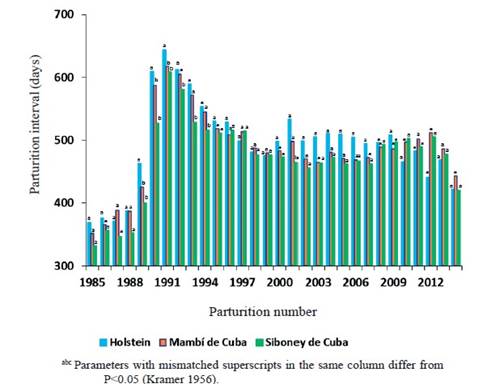
Figure 4 Effect of the interaction genotype x parturition year in parturition interval in Mambí de Cuba, Siboney de Cuba and Holstein.
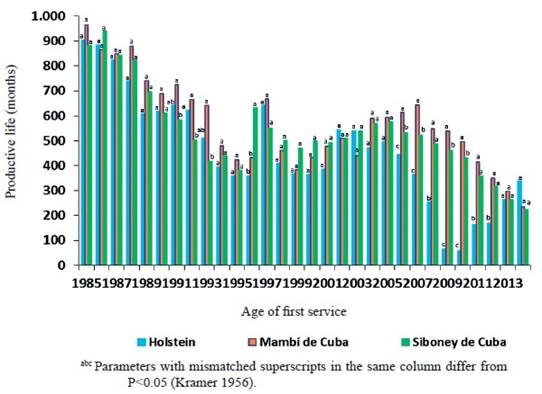
Figure 5 Effect of the interaction genotype x year of first parturition in the productive life in Mambí de Cuba, Siboney de Cuba and Holstein.
In general, the estimated averages for the milk production traits, reproduction and longevity in Mambí de Cuba, Siboney de Cuba and Holstein cows (table 5) showed higher cumulative milk productions up to 305 d in Mambí de Cuba and Holstein, however, Mambí de Cuba showed higher cumulative productions throughout life exceeding in 1299.13 kg to Siboney de Cuba and in 1 516.1 kg to Holstein. The Mambí de Cuba and Holstein showed similar reproductive performance. However, Siboney de Cuba showed better performance at younger ages at first parturition and lower reproductive intervals. The Mambí de Cuba also had a higher productive life, surpassing the Siboney de Cuba in 3.36 months and the Holstein in 11.46 months.
Table 5 Minimum square means (± standard error) for traits of milk production, reproduction and longevity in Mambí de Cuba, Siboney de Cuba and Holstein cows
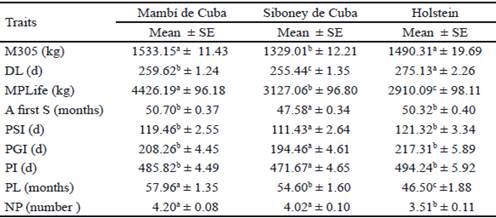
abc Parameters with mismatched superscripts in the same row differ to P <0.05 (Kramer 1956).
In the researchers conducted by López et al. (2009), in three cross-bovine herds (– Holstein (H) x ¼ Cebu (C), – Swiss (S) x ¼ C, 1/2H x 1/2C and 1/2S x 1/2C) in Veracruz , Mexico, the racial group also had a significant effect on milk production.
The cows –H x ¼C showed better milk production per lactation. The authors argue that this performance is due to the better environment, for the inclusion of concentrated supplements and the management of milking, without the support of the calves.
With respect to reproductive performance, López et al. (2006, 2009) reported that the increase in PGI in animals with higher proportions of Bos taurus genes is partially explained by an increase in milk production of these genotypes. The results also correspond to those of López et al. (2010), in different Bos taurus x Bos indicus crosses in Mexico, in which they observed that when increasing the percentage of Bos taurus genes also increased the parturition interval.
The results of this study showed that the genetic groups with higher milk potential (Holstein and Mambí de Cuba) have compromised their reproductive performance. Correspondingly, several authors establish antagonism between milk production and reproduction, especially at the beginning of lactation, a period in which there is greater demand for nutrients (Ferguson 1991, McClure 1995, Pedroso and Bonachea 1995 and Inostroza and Sepulveda 1999).
Ferguson et al. (1988) observed decrease of fertility by increasing milk production. They suggested that genetic selection to obtain higher producing cows has resulted in a concomitant selection of cattle with lower reproductive capacity.
De Luca (2017) explained that Holstein heifers had conception rates close to 70 %. This author showed that this breed is genetically fertile, although their mothers of high milk production have rates of approximately 40 %. This confirms that fertility problems are not genetic, but physiological and of management. According to the author, as milk production increases, the metabolic pathologies at the level of the uterus, the ovaries and the breasts, called “production diseases”, come to the forefront. It is considered, as the etiological cause of these diseases, an imbalance between the nutrients ingested with the foods, and those that are used and/or eliminated. This imbalance causes the “parturition syndrome” of the high-yield cow. It is understood as such all the pathological processes related to the tension to which the animal is subjected, from the advanced gestation until parturition, the later milk production and the new conception.
The results of this study showed that the Mambí de Cuba and Holstein have similar reproductive performance and higher milk production than the Siboney of Cuba. However, the latter showed better reproductive performance. The Mambí de Cuba showed higher productive life and higher milk production accumulated throughout life.











 text in
text in 







